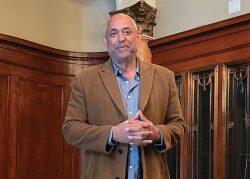Neveo Mosser has been in the San Francisco apartment market for his entire adult life. But as CEO of Mosser Companies, the multifamily company founded by his father Charles about 70 years ago, he has never seen a year like this one.
“2024 is going to be the year of incredible disruption,” he told TRD. “You’re going to see things go back and forth in an incestuous manner between operators, portfolios moving from one entity to another. This is the year of great opportunity and great disruption.”
Mosser said that the city never would have seen the current level of distress — from which his own company has not been immune — a generation ago when its multifamily housing stock was still mostly owned by mom and pops. Those independent owners were less leveraged and had more ties to the community, which stopped them from walking away from their buildings in other down markets, he said.
But “the typical story of greed” brought institutional capital to the city and led the Lembi family’s CitiApartments to eat up almost every larger building that came to market for several years until they lost most of it in the aftermath of the great financial crisis.
Veritas then bought the majority of that portfolio, before losing it themselves in a foreclosure to Brookfield in January. Mosser said the Veritas-Brookfield sale might be the biggest example of a debt note trade so far, but more are coming.
In the interview, Mosser talks with TRD about why San Francisco is “the most opportune place to look at multifamily in the United States”; why the election in November is the most important in the city’s history; and why savvy investors are buying notes, not buildings.
This interview has been condensed and edited for clarity.
What trends do you see in the apartment market?
More volume in transactions, but mostly on the smaller property side. People are coming into the city with 1031 exchanges because they see the opportunity. Astute Northern California owners are getting into the city now.
We’ve spun out a couple of smaller buildings over the past year, and we were not thrilled but still happy with the performance of the exit.
As a whole, what’s clouding our market is what I would call post-Lembi, part two. Institutional money is coming in and buying debt with the intention of foreclosing, and you can’t really value the building off the note sale because that comes with a lot of warts.
Everyone that I’ve talked to who has a national presence looks at San Francisco as being the number-one multifamily opportunity in the nation right now, primarily from the institutional side.
I’ve been around this industry for over 40 years and I’ve been through numerous down cycles but nothing is quite like what we’re having here. Between the rise in interest rates and the city being basically shut down for three years, that’s created a great opportunity because people know the city always comes back.
But between having the two leading universities in the U.S., if not the world, and a city that keeps attracting young entrepreneurs, the talent wants to be here. It’s always been a land of opportunity. These things ebb and flow, but now that people who were priced out can come back, they are taking advantage of that.
Where are you targeting your next investments?
The majority of the neighborhoods have returned not necessarily to their pre-pandemic rents, but pre-pandemic occupancy levels. We’ve always had a block-by-block, building-by-building approach to investments. So we’re active. It’s just a different behemoth right now because it makes more financial sense to go ahead and buy notes and hopefully be able to foreclose than to just buy the building.
We’re looking in L.A., San Diego, areas around San Jose. We’re constantly looking but the opportunity here in San Francisco is amazing right now.
How about Oakland?
We’ve been in Oakland since the early 1980s and if we go back five years ago, Oakland was a great alternative to being in San Francisco.
We can’t blame it necessarily all on the pandemic — and I don’t know how much of that you lay blame on the way that city has been run — but it’s a different market. I’m not seeing that recovery in Oakland. It would be harder to sell a building there than in San Francisco.
Let’s face it, it has a lot of problems and it’s about safety. If you’re not forced to stay in an area that’s not safe, then why stay there?
Are you looking at other Western markets — Seattle or Phoenix?
I had friends that invested in Scottsdale or Phoenix and, similar to what you saw with Sacramento, it just keeps getting bigger and bigger. People are seeing now that those expanding markets, like Austin and many of those Sun Belt places, have gone into a decline.
San Francisco is only 49 square miles and it’s not getting any bigger. That’s one of many reasons we’re very lucky to be here, and why this is probably the most opportune place to look at multifamily in the United States.
What keeps you up at night?
It’s the world we live in. It’s unsure. It’s scary times now.
What everyone wants is to feel safe. They want clean streets. They want decent public schools. They want to be able to recreate. Is quality of life different now than it was five years ago? Absolutely. When someone feels not safe, if they have the opportunity to live somewhere else, they’re going to go somewhere else.
How will the election in November impact some of these issues?
It’s a big election locally and across the country. This is probably the most important election that San Francisco has ever had, with the opportunity to look at new or novel ideas, community building and creating real coalitions amongst all people that are affected by these issues with making the people in the city feel safe, improving quality of life and public schools, and helping industries that want to be in San Francisco get their foot in the door.
I think there’s a lot of self-inflicted harm that we’ve done here in the city over the last 30 years, coupled with even everything that’s gone on over the last five years. It’s not all political, definitely. But I don’t think we’ve really helped ourselves.
With respect to Mosser, what can you tell us about the $88 million dollar portfolio that you defaulted on just a couple of months ago?
We have our long-term, decades-old family portfolio, and then we have some buildings that we’ve had with some of our investment partners. For the latter group, it’s the culmination of
what has happened over the three-year pandemic closure, plus the rise in interest rates, and if you had maturities that were coming up.
Ultimately, it’s up to the bank or the lender. Do they believe in San Francisco or are they watching Fox News continuously, or looking at the New York Post?
So far for us, the portfolio has not been sold and we still continue to operate it. We’re active and trying to go ahead and purchase that with another investor. So banks are really the key.
What approach are you taking to a workout?
I can’t get deep on the details on that, but the portfolio represents a very, very small percentage of the amount of properties that we own and operate.
How is the distressed portfolio you co-own with Swig different in that you have them as a partner?
In some of these older joint ventures that we have, we are not necessarily the controlling or the decision-making partner on that. … Again, it’s up to the lender. Do they want to work something out? For the most part we’ve been pretty successful in working with our lenders when we’ve had some things that matured.
We have rent stabilization laws and all kinds of other laws that just make it more onerous to own properties here and the last thing a bank wants to do is become an operator. Just finding insurance coverage is absolutely crazy. That, on the other hand, has created great opportunities for us, because we’ve been working with other lenders on taking over the operations of some of these buildings that they either have taken back or they’re going to want to change the operator.
How do investors feel about getting back into the market here?
You’re seeing people that are maybe the early adopters. But a lot of people want to make sure that we’ve hit the trough. For the majority of areas in San Francisco, I think that opportunity exists right now.
For core Tenderloin areas or parts of the Mission or Oakland as a whole, people are just scared. There is so much negative news out there — some of it real, some of it manufactured, probably for political purposes to paint the doom and gloom of the city just because of its background as being progressive. It sells a lot of stories, but it also puts a cloud over the overall viability of San Francisco across the world.
Mosser has investors that are institutional.
We’re on both sides.
Do you feel you’re contributing to the city’s troubles as well?
No, I don’t think that we’re contributing to it, because I don’t think there’s any goal to walk away from any property. We’ve been successful with working with our various lenders through these difficult times, where we’ve had loans that are coming up on maturities, and we’ve been aggressive in trying to purchase the note for ourselves.
Read more

